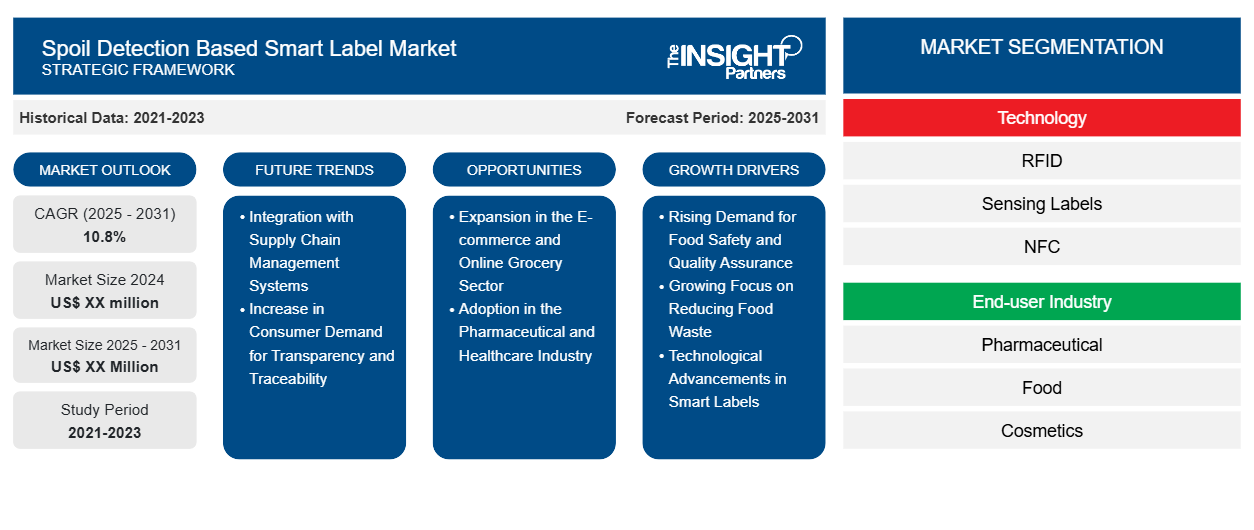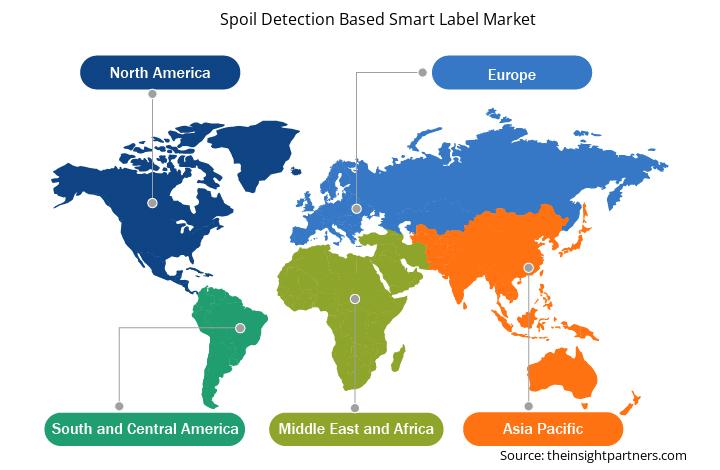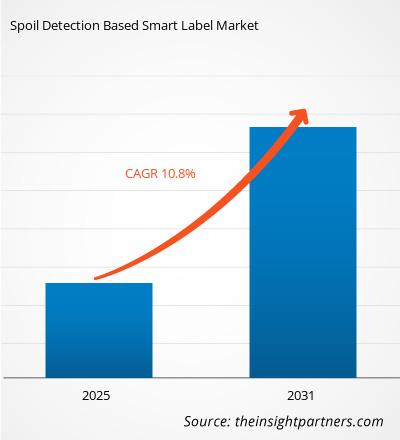腐敗検出ベースのスマートラベル市場は、2025年から2031年にかけて10.8%のCAGRで成長し、市場規模は2024年のXX百万米ドルから2031年にはXX百万米ドルに拡大すると予想されています。
本レポートは、テクノロジー(RFID、センシングラベル、NFC)、エンドユーザー産業(医薬品、食品、化粧品、その他)別にセグメント化されています。グローバル分析は、地域レベルと主要国別にさらに細分化されています。本レポートでは、上記の分析とセグメントの米ドル建て価値を提供しています。
報告書の目的
The Insight Partnersによる「腐敗検出型スマートラベル市場」レポートは、現状と将来の成長、主要な推進要因、課題、そして機会を解説することを目的としています。これにより、以下のような様々なビジネスステークホルダーに洞察が提供されます。
- テクノロジープロバイダー/メーカー: 進化する市場の動向を理解し、潜在的な成長機会を把握することで、情報に基づいた戦略的意思決定を行うことができます。
- 投資家: 市場の成長率、市場の財務予測、バリュー チェーン全体に存在する機会に関する包括的な傾向分析を実施します。
- 規制機関: 市場の濫用を最小限に抑え、投資家の信用と信頼を維持し、市場の健全性と安定性を維持することを目的として、市場における政策と警察活動を規制します。
腐敗検出に基づくスマートラベル市場のセグメンテーション
テクノロジー
- RFID
- センシングラベル
- NFC
エンドユーザー産業
- 医薬品
- 食べ物
- 化粧品
要件に合わせてレポートをカスタマイズ
このレポートの一部、国レベルの分析、Excelデータパックなど、あらゆるレポートを無料でカスタマイズできます。また、スタートアップや大学向けのお得なオファーや割引もご利用いただけます。
腐敗検出ベースのスマートラベル市場:戦略的洞察

- このレポートの主要な市場動向を入手してください。この無料サンプルには、市場動向から見積もりや予測に至るまでのデータ分析が含まれます。
腐敗検出ベースのスマートラベル市場の成長要因
- 食品の安全性と品質保証への需要の高まり:食品の安全性と品質への関心が高まる中、腐敗検知をベースとしたスマートラベルは、食品・飲料業界で不可欠な存在になりつつあります。これらのラベルは、腐敗をリアルタイムで検知することで、生鮮食品の鮮度と品質の監視に役立ちます。このトレンドは、食中毒、食品リコール、そして特に乳製品、肉類、魚介類といったデリケートな食品の安全性確保の必要性に対する消費者の意識の高まりによって推進されています。食品安全に関する規制が強化されるにつれて、腐敗検知技術の需要は高まると予想されます。foodborne illnesses, food recalls, and the need to ensure the safety of food products, particularly for sensitive items like dairy, meat, and seafood. As regulations around food safety tighten, the demand for spoil detection technology is expected to rise.
- 食品廃棄物削減への関心の高まり:食品廃棄物は世界的に深刻な問題であり、腐敗検知技術を搭載したスマートラベルは、製品の鮮度に関する正確かつリアルタイムの情報を提供することで、廃棄物の削減に重要な役割を果たします。これらのラベルにより、消費者、小売業者、流通業者は、生鮮食品の状態をより深く理解し、廃棄、消費、あるいは更なる加工を行うべきかどうかについて、情報に基づいた判断を下すことができます。サプライチェーン全体で食品廃棄物を削減するニーズの高まりが、腐敗検知技術の導入を促進しています。
- スマートラベルの技術進歩:材料科学、センサー、IoT接続における継続的なイノベーションにより、より高度で費用対効果の高い、腐敗検知をベースとしたスマートラベルが開発されました。これらのラベルはデジタルプラットフォームと統合可能になり、サプライチェーン全体の関係者にリアルタイムのデータとアラートを提供できるようになりました。この技術がより洗練され、手頃な価格で利用しやすくなるにつれ、食品、医薬品、化粧品など、様々な業界で導入が加速し、市場の成長を牽引しています。
腐敗検出ベースのスマートラベル市場の将来動向
- サプライチェーン管理システムとの統合:腐敗検知ベースのスマートラベル市場では、これらのラベルをより広範なサプライチェーン管理システムと統合する動きが拡大しています。腐敗検知ラベルを在庫管理システムや物流管理システムに接続することで、企業はサプライチェーン全体にわたって商品の鮮度と状態を追跡できます。この統合により、保管条件の最適化、適切な温度での製品輸送の確保、輸送中の腐敗の低減が促進され、業務効率の向上と損失の削減につながります。
- 透明性とトレーサビリティに対する消費者の需要の高まり:購入する製品に関するより多くの情報を求める消費者の需要に押され、食品生産とトレーサビリティにおける透明性の向上がますます求められています。腐敗検知機能を備えたスマートラベルは、製品の鮮度と品質に関するリアルタイムデータを消費者に提供し、透明性と安心感をさらに高めます。この傾向は、オーガニック食品、高級品、そして購入する製品の品質と安全性に関する詳細な情報を重視する健康志向の消費者といった分野において特に重要です。
腐敗検出に基づくスマートラベルの市場機会
- Eコマースおよびオンライン食料品セクターの拡大:オンライン食料品ショッピングとEコマースの成長は、腐敗検知ベースのスマートラベルにとって大きなビジネスチャンスをもたらします。消費者への直接配送の増加に伴い、生鮮食品が輸送中に品質と鮮度を維持することが不可欠となっています。スマートラベルは、顧客が配送された商品の鮮度を追跡し、製品の品質に関する安心感を提供するのに役立ちます。Eコマースプラットフォームが生鮮食品の輸送における課題に対処するための革新的なソリューションを模索している今、このビジネスチャンスは特に重要です。
- 製薬・ヘルスケア業界における導入:腐敗検出型スマートラベルは主に食品業界で使用されていますが、製薬・ヘルスケア業界においても有望なビジネスチャンスを提供しています。ワクチン、生物製剤、温度に敏感な医薬品など、多くの医薬品は、その有効性を維持するために厳格な環境管理を必要とします。スマートラベルは、温度変動、腐敗、製品劣化に関する重要な情報を提供することで、繊細なヘルスケア製品を新たなレベルで保護し、患者の安全確保に貢献します。これは、腐敗検出型スマートラベルにとって未開拓の市場を示唆しています。
腐敗検出ベースのスマートラベル市場の地域別分析
予測期間全体を通して、腐敗検出型スマートラベル市場に影響を与える地域的な傾向と要因は、Insight Partnersのアナリストによって徹底的に説明されています。このセクションでは、腐敗検出型スマートラベル市場のセグメントと、北米、ヨーロッパ、アジア太平洋、中東・アフリカ、中南米における地域についても説明します。

- 腐敗検出ベースのスマートラベル市場の地域別データを入手
腐敗検出ベースのスマートラベル市場レポートの範囲
| レポート属性 | 詳細 |
|---|---|
| 2024年の市場規模 | XX百万米ドル |
| 2031年までの市場規模 | XX百万米ドル |
| 世界のCAGR(2025年~2031年) | 10.8% |
| 履歴データ | 2021-2023 |
| 予測期間 | 2025~2031年 |
| 対象セグメント | テクノロジー別
|
| 対象地域と国 | 北米
|
| 市場リーダーと主要企業の概要 |
|
腐敗検出ベースのスマートラベル市場のプレーヤー密度:ビジネスダイナミクスへの影響を理解する
腐敗検知型スマートラベル市場は、消費者の嗜好の変化、技術の進歩、製品メリットへの認知度の向上といった要因によるエンドユーザーの需要増加に牽引され、急速に成長しています。需要の増加に伴い、企業は製品ラインナップの拡充、消費者ニーズへの対応のための革新、そして新たなトレンドの活用を進めており、これが市場の成長をさらに加速させています。
市場プレーヤー密度とは、特定の市場または業界内で事業を展開する企業または会社の分布を指します。これは、特定の市場空間における競合企業(市場プレーヤー)の数が、その市場規模または市場価値全体と比較してどれだけ多いかを示します。
腐敗検出ベースのスマートラベル市場で事業を展開している主要企業は次のとおりです。
- スマートラックテクノロジーグループ
- 薄膜エレクトロニクス ASA
- エイブリー・デニソン
- ゼブラテクノロジーズ
- アプライドインクソリューションズ
免責事項:上記の企業は、特定の順序でランク付けされているわけではありません。

- 腐敗検出ベースのスマートラベル市場のトップキープレーヤーの概要を入手
主なセールスポイント
- 包括的なカバー範囲: レポートでは、腐敗検出ベースのスマート ラベル市場の製品、サービス、タイプ、およびエンド ユーザーの分析を包括的にカバーし、全体的な展望を提供します。
- 専門家の分析:レポートは、業界の専門家とアナリストの深い理解に基づいて作成されています。
- 最新情報: このレポートは、最新の情報とデータの傾向を網羅しているため、ビジネスの関連性を保証します。
- カスタマイズ オプション: このレポートは、特定のクライアント要件に対応し、ビジネス戦略に適切に適合するようにカスタマイズできます。
したがって、腐敗検出型スマートラベル市場に関する調査レポートは、業界の状況と成長見通しを解明し、理解するための先導役となるでしょう。いくつかの妥当な懸念事項はあるものの、このレポートの全体的なメリットはデメリットを上回る傾向にあります。
- 過去2年間の分析、基準年、CAGRによる予測(7年間)
- PEST分析とSWOT分析
- 市場規模価値/数量 - 世界、地域、国
- 業界と競争環境
- Excel データセット
最新レポート
関連レポート
お客様の声
購入理由
- 情報に基づいた意思決定
- 市場動向の理解
- 競合分析
- 顧客インサイト
- 市場予測
- リスク軽減
- 戦略計画
- 投資の正当性
- 新興市場の特定
- マーケティング戦略の強化
- 業務効率の向上
- 規制動向への対応




















 無料サンプルを入手 - 腐敗検出ベースのスマートラベル市場
無料サンプルを入手 - 腐敗検出ベースのスマートラベル市場